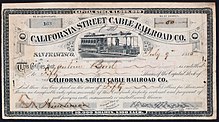
A cable car is a type of cable railway used for mass transit in which rail cars are hauled by a continuously moving cable running at a constant speed. Individual cars stop and start by releasing and gripping this cable as required. Cable cars are distinct from funiculars, where the cars are permanently attached to the cable.

The Pacific Electric Railway Company, nicknamed the Red Cars, was a privately owned mass transit system in Southern California consisting of electrically powered streetcars, interurban cars, and buses and was the largest electric railway system in the world in the 1920s. Organized around the city centers of Los Angeles and San Bernardino, it connected cities in Los Angeles County, Orange County, San Bernardino County and Riverside County.
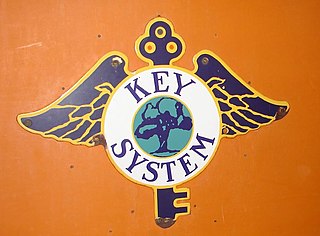
The Key System was a privately owned company that provided mass transit in the cities of Oakland, Berkeley, Alameda, Emeryville, Piedmont, San Leandro, Richmond, Albany, and El Cerrito in the eastern San Francisco Bay Area from 1903 until 1960, when it was sold to a newly formed public agency, AC Transit. The Key System consisted of local streetcar and bus lines in the East Bay, and commuter rail and bus lines connecting the East Bay to San Francisco by a ferry pier on San Francisco Bay, later via the lower deck of the Bay Bridge. At its height during the 1940s, the Key System had over 66 miles (106 km) of track. The local streetcars were discontinued in 1948 and the commuter trains to San Francisco were discontinued in 1958. The Key System's territory is today served by BART and AC Transit bus service.

The San Francisco cable car system is the world's last manually operated cable car system and an icon of the city of San Francisco. The system forms part of the intermodal urban transport network operated by the San Francisco Municipal Railway, which also includes the separate E Embarcadero and F Market & Wharves heritage streetcar lines, and the Muni Metro modern light rail system. Of the 23 cable car lines established between 1873 and 1890, only three remain : two routes from downtown near Union Square to Fisherman's Wharf, and a third route along California Street.

The Chicago City Railway Company (CCRy) was an urban transit company that operated horse, cable, and electric streetcars on Chicago's South Side between 1859 and 1914, when it became merged into and part of the Chicago Surface Lines (CSL) metropolitan-wide system. After that time it owned electric streetcars, along with gasoline, diesel, and propane – fueled transit busses. Purchased by the government agency Chicago Transit Authority (CTA) in 1947, it was liquidated in 1950.

The F Market & Wharves line is one of several light rail lines in San Francisco, California. Unlike most other lines in the system, the F line runs as a heritage streetcar service, almost exclusively using historic equipment both from San Francisco's retired fleet as well as from cities around the world. While the F line is operated by the San Francisco Municipal Railway (Muni), its operation is supported by Market Street Railway, a nonprofit organization of streetcar enthusiasts which raises funds and helps to restore vintage streetcars.

The San Diego Electric Railway (SDERy) was a mass transit system in Southern California, United States, using 600 volt DC streetcars and buses.
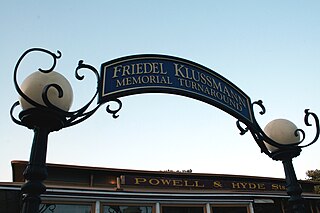
Friedel Klussmann was a prominent member of San Francisco society. She is credited with leading the campaign that saved the San Francisco cable car system in the 1940s and 1950s, and the foundation of the San Francisco Beautiful organization in 1947.

The Market Street Railway Company was a commercial streetcar and bus operator in San Francisco. The company was named after the famous Market Street of that city, which formed the core of its transportation network. Over the years, the company was also known as the Market Street Railroad Company, the Market Street Cable Railway Company and the United Railroads of San Francisco. Once the largest transit operator in the city, the company folded in 1944 and its assets and services were acquired by the city-owned San Francisco Municipal Railway. Many of the former routes continue to exist into the 2020s, but served by buses.
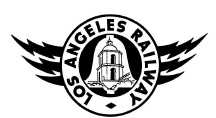
The Los Angeles Railway was a system of streetcars that operated in Central Los Angeles and surrounding neighborhoods between 1895 and 1963. The system provided frequent local services which complemented the Pacific Electric "Red Car" system's largely commuter-based interurban routes. The company carried many more passengers than the Red Cars, which served a larger and sparser area of Los Angeles.

The Chicago Surface Lines (CSL) was operator of the street railway system of Chicago, Illinois, from 1913 to 1947. The firm is a predecessor of today's publicly owned operator, the Chicago Transit Authority.

Streetcars or trolley(car)s were once the chief mode of public transit in hundreds of North American cities and towns. Most of the original urban streetcar systems were either dismantled in the mid-20th century or converted to other modes of operation, such as light rail. Today, only Toronto still operates a streetcar network essentially unchanged in layout and mode of operation.
W. L. Holman Car Company was a streetcar and cable car manufacturer based in San Francisco, California. It mainly built equipment for rail operation, including San Francisco Municipal Railway's first publicly owned streetcar, and some of the cable cars still operating on San Francisco's California Street line. Holman also constructed heavy interurban coaches and combines that ran on inland California electric railroads including Petaluma and Santa Rosa Railroad, Sacramento Northern Railway, and Central California Traction Company, as well as the Sierra Railroad, a Common Carrier line which operated out of Jamestown, California.
The San Francisco and San Mateo Electric Railway (SF&SM) was the first electric streetcar company in San Francisco, California. The company was only in business for ten years, starting from 1892 until it was merged into the United Railroads of San Francisco (URR) in 1902.
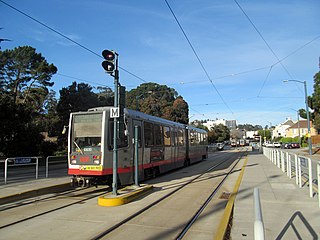
St. Francis Circle is a light rail stop on the Muni Metro K Ingleside and M Ocean View lines, located in the St. Francis Wood neighborhood of San Francisco, California. It opened around 1907 when the United Railroads (URR) expanded its Ocean Avenue line west to Ocean Beach; Muni service followed with the K in 1918 and the M in 1925.

Junipero Serra and Ocean is a light rail stop on the Muni Metro K Ingleside line, located in the St. Francis Wood neighborhood of San Francisco, California. It originally opened around 1896 on the United Railroads 12 line; K Ingleside service began in 1919.
Streetcars in Los Angeles over history have included horse-drawn streetcars and cable cars, and later extensive electric streetcar networks of the Los Angeles Railway and Pacific Electric Railway and their predecessors. Also included are modern light rail lines.
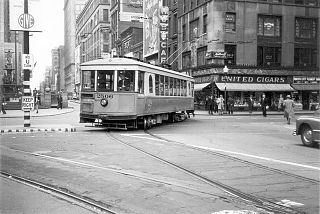
Streetcars operated by the Cincinnati Street Railway were the main form of public transportation in Cincinnati, Ohio, at the end of the 19th century and the start of the 20th century. The first electric streetcars began operation in 1889, and at its maximum, the streetcar system had 222 miles (357 km) of track and carried more than 100 million passengers per year. A very unusual feature of the system was that cars on some of its routes traveled via inclined railways to serve areas on hills near downtown. With the advent of inexpensive automobiles and improved roads, transit ridership declined in the 20th century and the streetcar system closed in 1951.

A California Car is a type of single-deck tramcar or streetcar that features a center, enclosed seating compartment and roofed seating areas without sides on either end. These cars were popular in California's mild Mediterranean climate offering passengers a choice of shaded outdoor seating during hot weather, or more protected seating during cool or rainy weather. They were also used in other climates to provide separate outdoor smoking and enclosed non-smoking areas. Some very early motor buses also used the combination car design.

